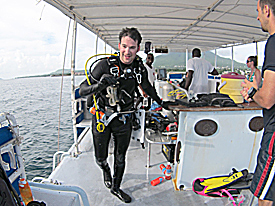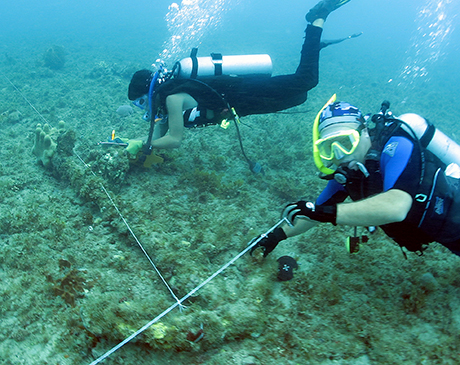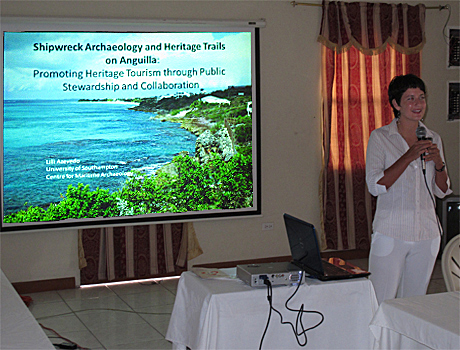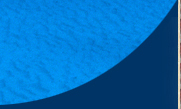

Collaboration and Plan B
June 28 2011
By Chris Cartellone and
Lillian Azevedo

Justin Parkoff after a dive. (Photograph by Paul Diamond.)
We accomplished all of our goals for this week, but have had a slower than desired start to the diving. The choice of boats for the research is very limited on the island, and unfortunately this week the dive shop vessels have had engine problems. Replacement parts have just arrived, and hopefully this will allow us to resume daily diving operations beginning this week. Such is the normal life of an underwater archaeologist operating under time constraints with limited resources.
More positively, we were thrilled to discover that everything survived shipment from the United States without being damaged at sea or lost in Customs. We succeeded in delivering twenty new scuba tanks to the local dive shop to support our operations. Despite the challenges, we did dive on two days over the past several, and spent the remaining time productively collecting, assembling, and checking all of our equipment, and visiting with the Nevis Historical & Conservation Society members. The project is picking up pace and should be running with full sails this coming week.
With the dive shop vessels handicapped we switched to Plan B. On Wednesday, the Nevis Air & Sea Ports Authority provided use of their police boat. Justin and Chris located the site by using diver tow-boarding. Using mask, fins, and snorkel, Chris was pulled behind the boat by holding onto a rope, and covered the area until he recognized cannons on the seafloor. Next, Justin deployed a buoy while Chris recorded the position with GPS. This established our initial working position. We returned to the site on Friday afternoon with the marine biology field school from Finger Lakes Community College. We used the dive to compare last year's plan to the site, while relocating major artifacts and connecting them with guidelines. We were pleased to find the site appeared undisturbed. While many of these students flew home on Saturday, Professor James Hewlett and some of his team will remain to help continue recording the site this week.

Lillian Azevedo and James Hewlett recording anchor. Place mouse over image to highlight the anchor. (Photograph by Paul Diamond.)
Our goals for this coming week are fairly straightforward: to run a magnetometer over the area to identify potential concentrations of artifacts, and continue using divers to survey and record the site. Aiding us in this process the past couple days is visiting archaeologist Lillian Azevedo. She is a Ph.D. candidate from the University of Southampton completing her research on Anguilla. On Friday she presented her research to the community in a talk sponsored by the Nevis Historical & Conservation Society. Her work recording Anguilla's Underwater Cultural Heritage, understanding challenges, and developing management initiatives there offers a parallel to the situation on Nevis.

Lillian Azevedo presenting Anguilla research. (Photograph by Chris Cartellone.)
The nature of marine archaeology and the limited resources on many islands in the region creates an opportunity and necessity for collaboration. Professor Hewlett's experience in biology and Lilli's research on regional challenges in heritage management add breadth to the survey, as we consider the potential impacts for not only Nevis but future work throughout the region. Similarly, Solebay's history is being thoroughly investigated by two scholars in England, David Small and Brian Littlewood from the University of Bristol. They have exerted invaluable effort in digging through the archives to reveal the history of the vessel and its captain. Even as this project progresses, they continue to update the team of their finds through email. Such shared resources and efforts from so many people directly provides for the success, and even possibility, of the project.
If you have questions or comments, please email us at cartellone@tamu.edu.
Return to MUA Project Journals home page.

